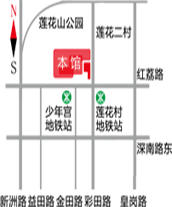
- The Only Way for Ink Painting Transformation
-
Lu Hong
——Explanation on "Ink Transformation - Contemporary Chinese Ink Painting Exhibition"
Lu Hong
As long as we clean up the clues of the development of modern Chinese art history, it is not difficult to find that since the outbreak of the May Fourth Movement in 1919, every major political change in the mainland inevitably leads to a great discussion and change in the reform of ink painting. Such as the establishment of New China, the Great Leap Forward, and the Cultural Revolution. The convening of the Third Plenary Session of the 11th Central Committee of the Communist Party of China in 1978 once again sparked a great discussion on this sensitive topic in the mainland ink painting industry. At that time, the modernization of economy and science became the center of attention for the whole society. Therefore, for a long time, "modernity" has become a fundamental concept that many ink painters in mainland China have adhered to. In fact, the transformation of ink painting in mainland China is not only based on the construction of modern society and the call for modern ideas, but also almost 30 years later than the exploration of modern ink painting in Taiwan and Hong Kong.
Just like the modern ink painting exploration that emerged in Taiwan and Hong Kong, the modern ink painting exploration in mainland China is also based on the development clues of Western modern art history. For example, in the context of the famous "85 New Wave", there have been many explorations in the mainland ink painting industry that draw inspiration from Western modern art. It can be said that from expressionism to surrealism, then to abstractionism, minimalism... all formal concepts that can be transplanted into ink painting have not been missed. As far as I know, for most young ink painters, borrowing is not the end in itself, but hoping to find a new way to transform traditional ink painting into modernity. In this process, Western modern art is largely a critical tool. It symbolizes both the freedom of art and the liberation of thought. Unfortunately, although the cultural strategies of "anti tradition" and "aligning with the West" have greatly opened up many people's artistic ideas, at the same time, they have significant practical and historical significance in expanding new aesthetic fields, spreading modern concepts, inspiring new thinking, encouraging creative spirit, innovating national consciousness, and creating a diversified situation. But it also brings about an extremely serious problem of "de Sinicization". Under the traction of Western modern art, Chinese modern ink painting has gradually lost its own context as a whole. One thing we cannot avoid is that modern Chinese ink painting does not naturally extend and grow from traditional culture. Its visual resources and conceptual resources mainly come from the West. As a result, many works have traces of directly imitating Western modern art, both in terms of concept and technique, which is clearly due to the so-called "book effect" and "picture book effect". Furthermore, in the 1990s, some modern ink artists even resorted to following the "Chinese style imagination" of Western curators in their artistic creations in order to go global. Moreover, although some artists express ideas and cultural issues that are extracted from the reality of China, their artistic techniques are direct imitations of Western modern art. This not only results in a significant lack of originality in many works, but also leads to a lack of artist identity. Of course, despite these serious issues, we cannot simply negate the "85 New Wave" and thus negate all modern ink painting. Because the radical cultural choices and criticisms that emerged at that time were only strong opposition and strong resistance to traditional negative factors that stubbornly hindered cultural development, which had considerable historical rationality. From another perspective, many young artists at that time could not consciously seek new development from tradition. This is because in the era dominated by the "far left" ideology, traditional civilization was all placed within the scope of the "decadent and declining ideas of the feudal landlord class", coupled with a serious lack of education. Therefore, most of the young ink artists who were very active during the "85 New Wave" period had little understanding of traditional knowledge, so they completely devoted their energy to learning and digesting Western knowledge. Until the late 1980s, many young artists did not have the time and rationality to consider their cultural traditions - this cannot be blamed on them, and it should be the people who caused this historical phenomenon to take full responsibility.
I have noticed that since the early 1990s, a small number of modern ink wash artists have begun to realize the local value of constructing "Chinese characteristics" and are striving to return to their own context. People like Zhu Xinjian, Li Jin, Liu Qinghe, Li Xiaoxuan, Li Huasheng, Wang Chuan, and others have good reference and development of tradition when expressing personal current feelings, and also have artistic historical significance. This means that contemporary Chinese ink painting art has finally entered the process of "re sinicization". Unfortunately, some modern ink artists have not realized the importance of this issue. So, until the beginning of the new century, the issue of "de sinicization" or "westernization" still existed in contemporary Chinese ink painting art, which was also an important reason why Sun Zhenhua and I planned the "reshuffle" exhibition in 2001. [1] Our aim at that time was to hope that artists could find ways to seek inspiration from tradition and do their best to solve the problem of the disconnection between contemporary Chinese ink painting art and tradition. It has been proven that many participating artists have done very well in their works, which has also played a positive role in promoting the development of contemporary ink painting in the future.
It is precisely for the above reasons that Mr. Ackermann and I jointly planned the "Ink Transformation - Contemporary Chinese Ink Painting Exhibition", aiming to demonstrate the core values of emphasizing the close connection between China's new ink painting and traditional context, as well as the close connection between new ink painting and contemporary Chinese culture. In our view, this should be the basic prerequisite for the transformation of contemporary Chinese ink painting, and none of them are indispensable. It is also our basic criterion for selecting artists and works. We hope that this exhibition can play an important role in promoting the continuity, uniqueness, and self-esteem principles of contemporary Chinese ink painting art.
Here, I would like to emphasize that unlike contemporary Western artists, the artists participating in this exhibition are more concerned about the cultural issues they empathize with, starting from their own cultural traditions and current cultural backgrounds. Even when dealing with cultural issues that are equally important to contemporary Western artists, they have a different way of understanding and expression than contemporary Western artists. In the globalized landscape that emphasizes diversity, tolerance, and equality, it is crucial to highlight the national identity of Chinese contemporary art and demonstrate its uniqueness and differences from Western contemporary art. Because of this, the participating artists easily traveled through the East and West; Traditional and contemporary; Abstract and concrete; Realism, expression... have moved towards a more comprehensive and updated approach. They use their own works to strongly demonstrate that tradition is not established, but created. Over time, they will surely create even more brilliant artistic achievements.
Furthermore, I would like to point out that advocating for the inheritance of historical context is not the same as extreme nationalism. The latter is a passive inheritance, while the former is a creation based on the present. A world art history has long taught us that both Eastern and Western civilizations are the result of the collision of different cultures. In the world we live in, there is no pure and pure cultural existence that is not influenced by other cultures. So, we cannot refuse to learn foreign cultures in the name of maintaining traditional purity, just like fundamentalists. We cannot underestimate ourselves and blindly copy foreign cultures. This means that in the current cultural context, we must not only oppose Western centrism, but also oppose Eastern centrism. Only in this way can we have a broader cultural perspective in a process of colliding globalization.
Wishing this exhibition a complete success!
On May 8, 2012, in Qianhai New Area, Shenzhen
Note:
[1] Please refer to the picture album of the same name "Reshuffle", Hunan Fine Arts



